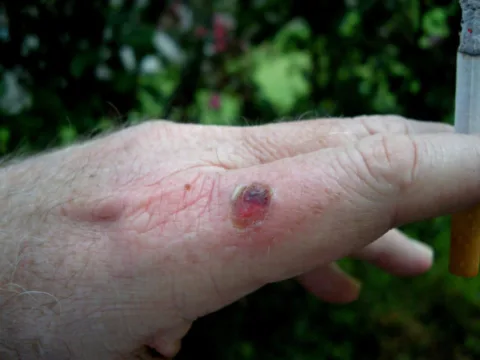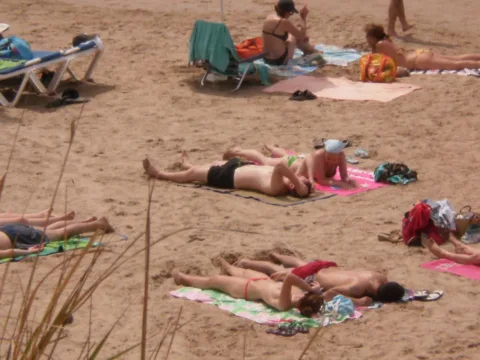I had a weird spot on my leg that my dermatologist told me I should have removed. Yep, I was about to have my first skin biopsy.
It was an odd-looking, freckle-like spot — an irregularly shaped brown spot a few millimeters in size, which was too small to be a mole, but too large to be a regular ol’ freckle.
What was going on?
That’s what my dermatologist wanted to know, too, as she examined the odd spot on my leg carefully, manipulating it with her gloved fingers.
My skin spot had the following characteristics:
- It measured approximately 5 millimeters in diameter.
- Its color was dark brown and appeared to have darkened over time.
- The spot was asymmetrical.
- It had changed in size and appearance over the previous few months.
While the spot on my leg was small, what gave my dermatologist cause for concern was the fact it was asymmetrical, dark, and had gotten larger over time.
My doctor decided to play it safe, and so did I. Electing to have the skin spot removed, I stayed in the office beyond the usual length of my skin screening and prepared for the excision.
What It’s Like To Have A Skin Biopsy
In walked the dermatologist’s nurse, who swabbed the spot with lidocaine and then alcohol to sterilize the skin removal site.
I knew what was coming next — the razor.
The doctor gave the lidocaine she applied to my skin a few moments to kick in and help numb the area before the biopsy.
Next, she squeezed a chunk of skin around the site of the spot, pulling up on the affected area of skin to ensure that when her razor blew across the spot, it would remove the entire spot with clear margins on all sides, including under the spot.
Out the razor came. While I cringed at the sight of the sinister-looking medical tool, I actually decided to watch the procedure as it took place.
The dermatologist inserted the head of the blade just about 3 millimeters away from one edge of the skin spot, and within just a couple seconds she had managed to cut the spot from my body.
Left behind was a pinkish, bleeding patch of dermis that was quickly covered with a cotton swab and bandage.
The biopsy (or surgery, as the dermatologist called it) may have been over, but my anxiety was just about to kick in… what in the world was it that she removed? Was it cancer? I’ll tell you what it was in a moment.
But first, here’s what to look for if you ever have a weird skin spot…
Spotting Skin Cancer Is As Easy As A-B-C (and D & E)
If you’re like me and you worry about getting skin cancer, then you probably obsess over every speck, mark, and spot on your skin that doesn’t “look right.”
But what do dangerous skin spots look like?
Most dermatologists say to watch out for the ABCDEs of skin cancer:
- A — Asymmetry
- B — Border Irregularity
- C — Color Variety
- D — Diameter Greater Than 5 Millimeters
- E — Evolving Appearance Over Time
Does that mean every spot on your skin that’s asymmetrical, has irregular edges, changes or deepens in color, or is larger than 5 millimeters poses a danger?
Not necessarily. But that doesn’t mean a non-cancerous skin spot isn’t a pre-cancerous lesion that, given time, could turn into any of the following:
So, going to the dermatologist as soon as possible for a screening when you see a strange-looking spot on your skin could mean the difference between preventing skin cancer or being diagnosed with one of those dangerous skin diseases!
The Best Ways To Avoid Skin Cancer
While fair-skinned people such as myself stand the highest risk of skin cancer due to sun exposure, everybody — including those with darker skin — should be aware of the risks of skin cancer.
Here’s what you can do to reduce your risk of getting skin cancer:
 Avoid being outdoors in the sun between the hours of 10 AM and 4 PM, when the sun’s rays are the most intense.
Avoid being outdoors in the sun between the hours of 10 AM and 4 PM, when the sun’s rays are the most intense.- Always look for shade, especially during the late morning and early afternoon hours.
- Cover up as much skin as possible with UV-protecting clothing, and wear a hat to help keep the sun’s rays from hitting your head (especially if you’re going bald like me). Wide-brimmed hats do double duty in protecting not just your head, but also your face, neck, and ears.
- Wear sunglasses with 99% or greater UV absorption to keep the sun from doing damage to your eyes.
- Apply sunscreen and lip balm with a Sun Protection Factor (SPF) of 30 or higher.
- Don’t tan. Plain and simple. Just don’t. There’s no good reason to get a tan — unless you want to damage your skin and increase your risk of getting skin cancer.
What My Skin Biopsy Revealed
After my biopsy, I waited a few days for the pathologist’s office to inspect the skin that was removed from my body.
But, soon enough, I received the call I had been waiting for.
My skin spot was totally benign — non cancerous.
But my dermatologist said it was very wise that I chose to have it removed. The fact the spot had grown and deepened in color could’ve meant it would turn dangerous over time.
I was lucky — and I was proactive.
When it comes to skin cancer, luck often comes in greater doses the earlier a skin spot is professionally examined and completely removed.
If you’re concerned about a weird spot on your body, call your dermatologist today.
Believe me, you’ll be glad you did. The biopsy procedure really isn’t bad at all!
More Skin Cancer & Biopsy Info
- 10 Little-Known Facts About Suncreen, SPF & Skin Cancer
- 38 Causes Of Discolored Skin Patches
- Skin Biopsy Explained
- Photos & Tips For Getting Through Melanoma Skin Cancer Surgery & Recovery
- Having A Skin Biopsy? Here’s What You Can Expect
- Will One Bad Sunburn Give You Skin Cancer?
- Simple Steps To Reduce Your Skin Cancer Risk






